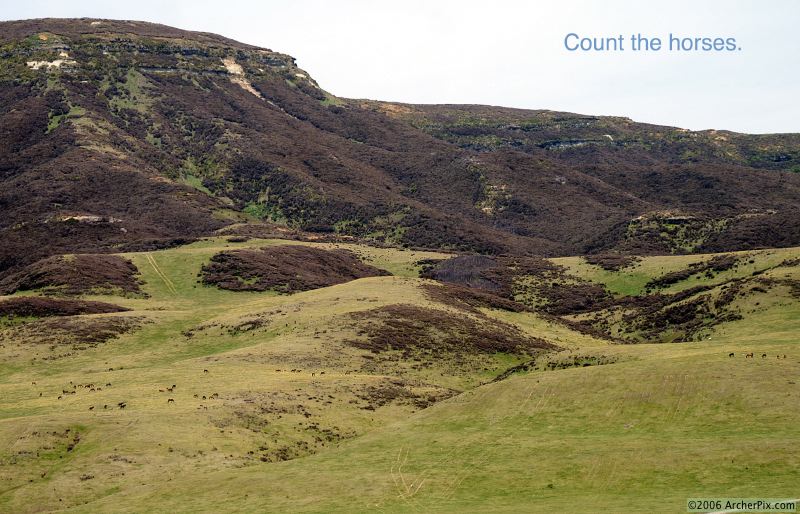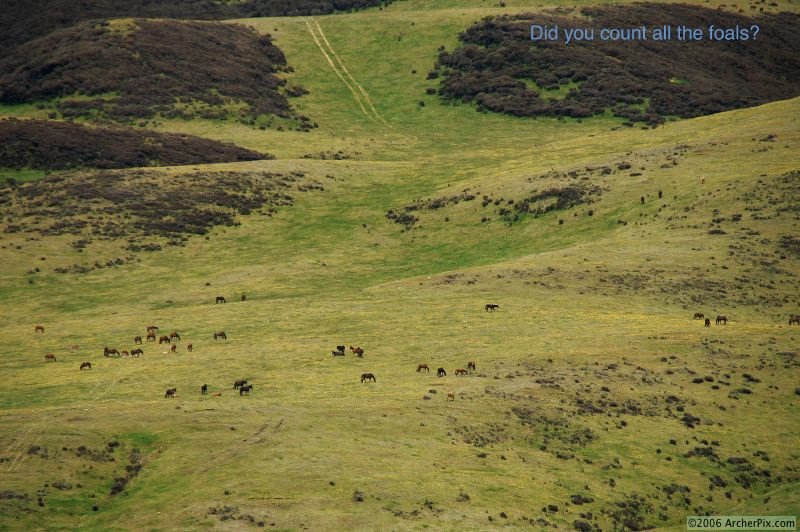The
first horses were introduced into New Zealand by Samuel
Marsden in December 1814.
In 1876 the first wild horses were recorded in the
Kaimanawa mountains. These are likely to have been
descendants of horses which came into the area with
travellers, explorers, settlers, soldiers and Maori
traders.
In 1858 Major George Carlyon imported Exmoor
ponies to Hawkes Bay. These were crossed with local
stock and a sure-footed pony known as the Carlyon pony
resulted.
Sir Donald McLean imported two Welsh stallions, Kinarth
Caesar and Comet. When crossed with the "Carlyon" a
small statured, sure footed, robust horse resulted.
These horses became known as the "Comet" breed.
During the 1870's McLean released a Comet stallion and
several mares on the Kaingaroa Plains. In later years
this bloodline was reportedly apparent in the wild
population. (I have seen these. Their heads looks like
those of donkeys; too big for the body, rounded and
covered with long shaggy hair. JA)
Over the years that followed, other horses contributed
to the bloodline of this wild population. There were
escapes and releases of horses from sheep runs in the
area and in 1941 horses from the mounted rifle cavalry
units at Waiouru were released when a strangles epidemic
threatened.
(I have seen no confirmation of this. Army sources
say the mounted rifles with their 1500 horses moved
from Waiouru to the Waikato. But with 1500 horses tied
in lines close together and not much fencing, a few
may have escaped and joined the wild herds nearby. JA)
It is also reported that Nicholas Koreneff released an
Arab stallion into the Argo Valley region during the
1960's.
(Lance Nukunuku of the Waiouru Saddle Club says a
Clydesdale was released to increase the body-size of
the herd. The white clydesdale nose-stripe can now be
seen on many Kaimanawas. JA)
With the varied gene input that followed their origins,
the horses have generally become larger in stature than
their pony forebears and there is also some variance in
their conformation and build. The horses are however,
generally known for their calmness and inquisitiveness
and in many of the herds, the classic characteristics of
the Comet breed are still clearly exhibited.

The
shepherd’s hacks that grew too old for mustering or
pack-horse work on Taihape and Taupo sheep farms were
released onto the plains for a quiet retirement with the
herds, and other younger horses from the herds were
rounded up and broken in to replace them.
With the coming of Land-Rovers, motor bikes and quad
bikes on hill country farms, the use of horses on farms
has greatly decreased and the wild horses were
shot for dog tucker or sold for pet food and in 1979 it
was found that only about 174 horses remained.
Starting in 1981, the Kaimanawa population, range size,
and herd movements began to be officially measured, and
a protected area was formed for the breed in the Waiouru
Military Training Area. Legislative protection was
similar to the kiwi and other native species. Following
the protection of the breed, there was a rapid increase
in the herd size, and by 1994, 1,576 horses were known
to exist in the area.
A plan to reduce the impact of horses on land with
important ecological values was prepared. The
protection provided to the horses was lifted in 1996.

With the Kaiangaroa plains now covered with dairy farms
and pine plantations, and the Mokai Patea now fenced off
for sheep farming, the wild horses were now largely
restricted to the Army Training Area that occupies 600
sq km in the south-west of the Kaimanawa Ranges. The
habitats in the higher parts of these ranges are ancient
and unique, with many rare, slow-growing and fragile
species of alpine plants. Some of the places in higher
northern parts of the Army Training Area have been
gazetted as Restricted Ecological Areas.
Also there is no fence between the tussock lands of the
west side of the training area and the Desert Road where
3000 cars and 500 large trucks travel each day.
A management plan for the horses requires them to be
kept out of the fragile areas, and away from the Desert
Road. Helicopters keep the wild horses mustered away
from the northern and western parts of the training
area, and they are now mostly seen in the south-east
part of it, in the Imjim Valley, Argo Valley, Home
Valley and Tarn Track regions of the training area. Each
herd marks its territory by depositing its droppings in
one big pile on tracks other horses might use.
Consequently the roads in the Imjim/Argo/Home/Tarn
region need careful negotiation!
The herd size is kept to 500 to stop over-grazing of
this area. Each year, around April, officers of the
Department of Conservation (DoC) use a helicopter to do
a head-count.The number of surplus horses is identified
and around the middle of June the horses are mustered by
helicopters to a set of yards in a canyon at the western
end of the Argo Valley.


Kaimanawa
breeding herds range in size from 2 - 21 animals with a
typical group consisting of a stallion, two or three
mares and two or three foals. When horse treks ride
through this area each December, lone stallions often
approach the mares in the trek, trying to entice them
away.

In the midwinter of 2009 the herd of about 15 horses
from Home Valley came right into the camp each night.
The grass on the camp training field was sweet, and the
walls enclosing the heated swimming pool were warm!
Piles of horse droppings appeared at street
intersections as stallions marked their territories.
|




